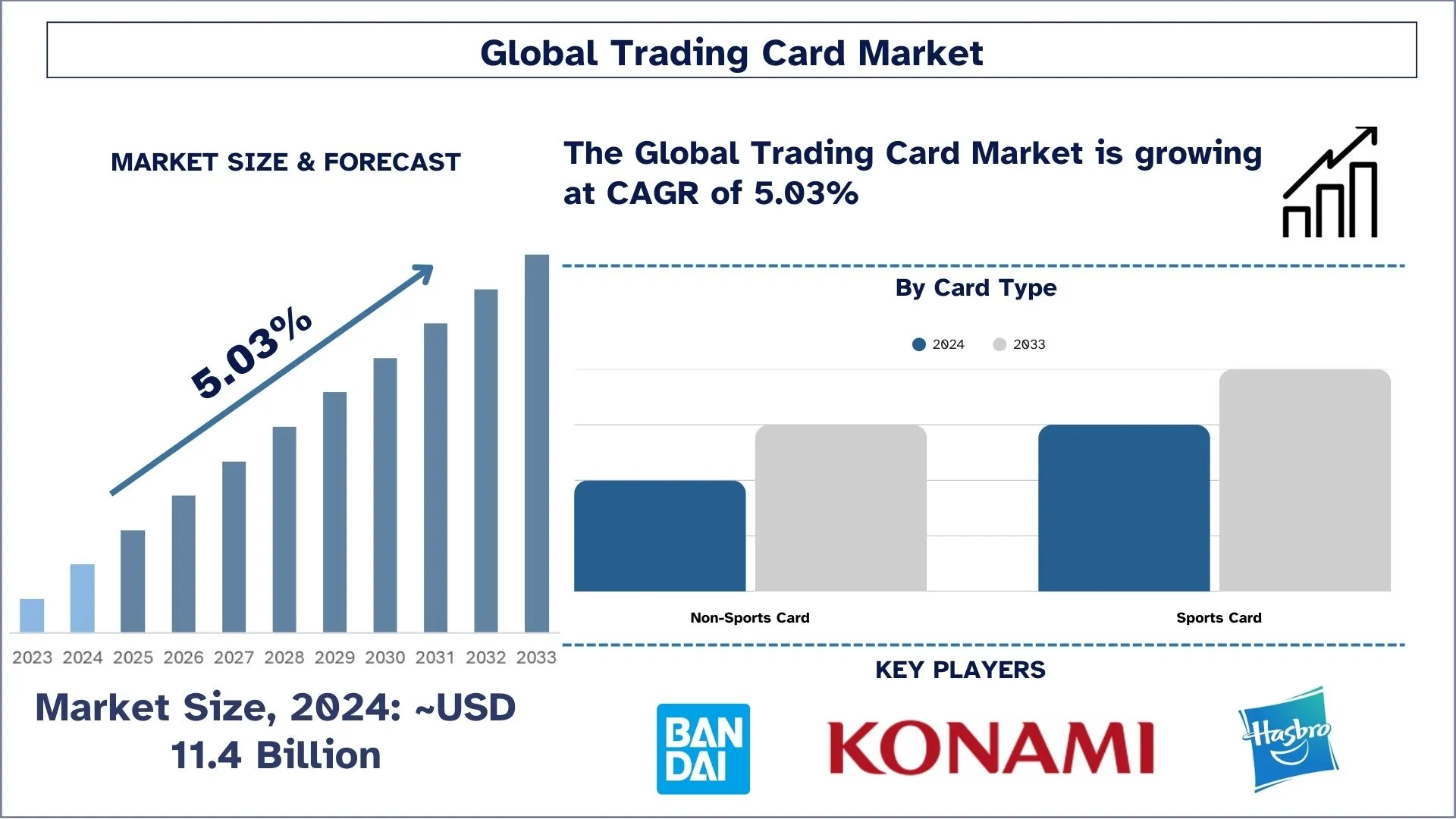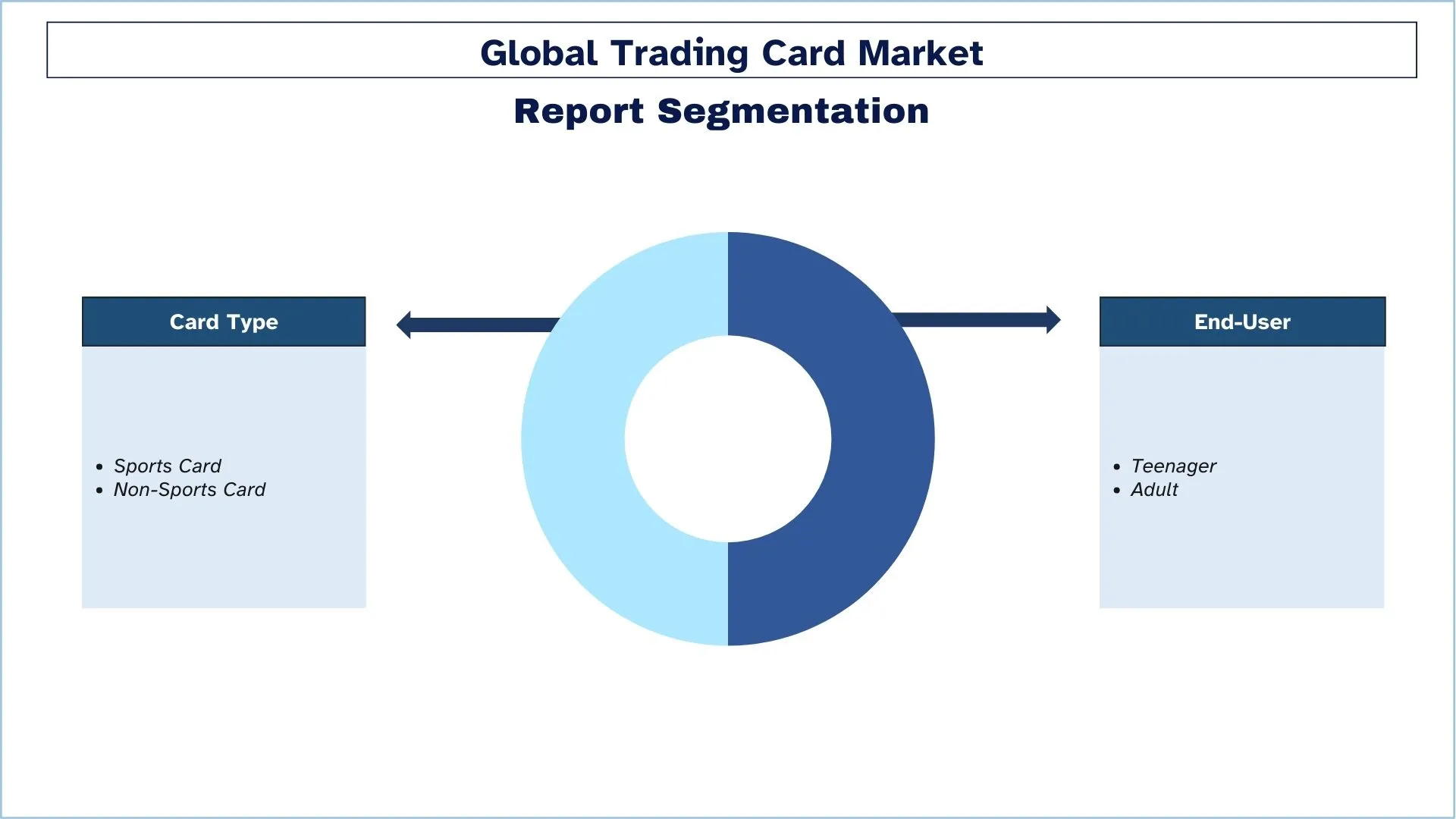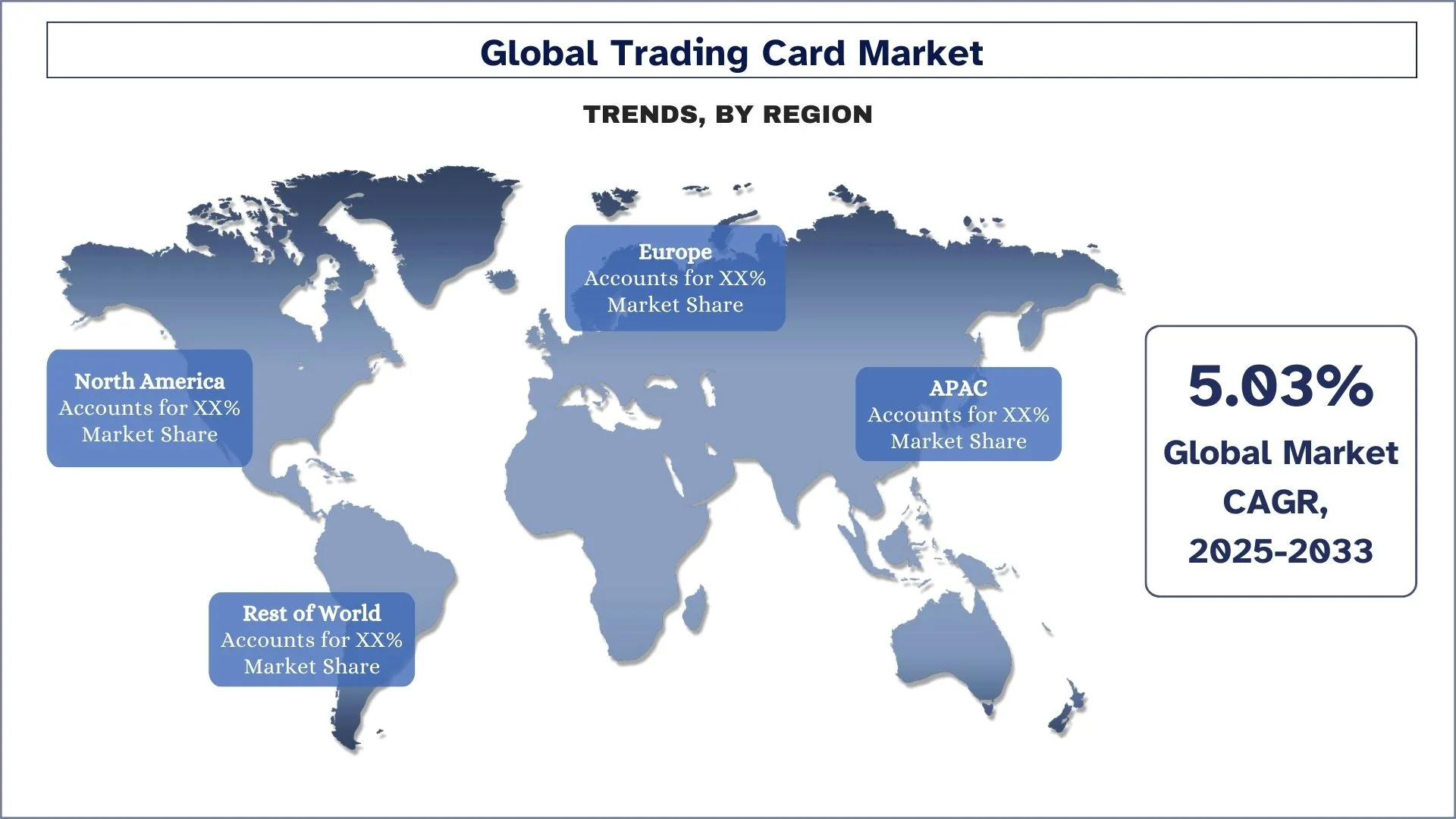- Home
- About Us
- Industry
- Services
- Reading
- Contact Us
Trading Card Market: Current Analysis and Forecast (2025-2033)
Emphasis on Card Type (Sports Card and Non-Sports Card); End User (Teenager and Adult); and Region/Country

Trading Card Market Size & Forecast
The Trading Card Market was valued at approximately USD 11.4 billion in 2024 and is expected to grow at a substantial CAGR of around 5.03% during the forecast period (2025-2033), owing to growing interest in collectibles and alternative investments.
Trading Card Market Analysis
The market for trading cards has experienced a surge in popularity as an alternative investment and speculative asset class. Investors have acknowledged the potential for significant returns, particularly due to the rise in card values in recent years. As a result, there has been a substantial influx of financial capital onto the market, leading to unprecedented price levels. A notable example of this trend is the recent sale of a rare Pokémon card. In January 2021, an ungraded 1999 Pokémon First Edition Base Set Charizard card was sold for an astonishing $350,100 in an online auction. This sale not only highlighted the interest of speculators in trading cards but also demonstrated the increasing acceptance of these collectibles as a viable investment option. Moreover, the COVID-19 pandemic and the resulting economic uncertainties have sparked a renewed interest in alternative investments such as trading cards. With traditional investment markets experiencing volatility, individuals seeking diversification and the potential for high returns have turned their attention to the trading cards market.
Trading Card Market Trends
This section discusses the key market trends influencing the various segments of the Trading Card market as identified by our research experts.
Integration of Blockchain and NFTs in Trading Cards
A trend that characterizes the contemporary trading card industry is the application of blockchain technology and NFTs. These technologies are facilitating ways to own, track, and verify the authenticity of digital cards that suit collectors and investors. Both established businesses and new innovators have chosen to enter the digital trading card market to buy and sell limited edition trading cards online. This revolution is not only a modernization of the trading card but also additional income sources and opportunities for fans in other countries, instead of only physical cards.
Trading Card Market Industry Segmentation
This section provides an analysis of the key trends in each segment of the global Trading Card market report, along with forecasts at the global, regional, and country levels for 2025-2033.
The Sports Segment is Expected to Witness a Higher CAGR than the Trading Card Market.
Based on card type, the market is bifurcated into sports and non-sports. The sport segment dominated the market and is expected to behave in the same fashion in the forecast period. The popularity of sports, such as baseball, basketball, football, soccer, and hockey, has contributed to the demand for trading cards featuring athletes from these sports. Moreover, technological advancements in the field of sports trading cards have played a role in the growth of the market. Moreover, digital trading cards are becoming increasingly popular, and this trend is expected to continue in the forecast period.
The Teenager Segment Holds the Largest Share of the Market.
Based on end user, the market is bifurcated into teenager and adult. Among them, teenagers hold a significant share of the market in 2024. Trading card games, such as Pokémon and Magic: The Gathering, have gained immense popularity among teenagers, which involve collecting and trading, and providing a social and competitive aspect for teenagers. Additionally, trading cards provide teenagers with an opportunity to connect with other collectors and engage in social activities, such as card shows and conventions.

APAC has a significant share of the market in 2024.
The Asia Pacific region has dominated the trading card market in the historic years and is expected to dominate in the forecast period due to the large population of avid collectors, enthusiasts, and fans of various genres, including sports, anime, and pop culture. Moreover, the Asia Pacific region has experienced significant economic growth, leading to an increase in disposable income among individuals. This rise in purchasing power has allowed more people to participate in the trading card market, investing in their favorite cards or sets. The allure of trading cards as a potential investment opportunity has also attracted individuals looking to profit from the appreciation of rare or sought-after cards. Furthermore, the Asia Pacific region has witnessed a surge in popularity for competitive trading card games. Games like Pokémon, Yu-Gi-Oh, and Magic: The Gathering have developed vibrant player communities, with regular tournaments and events attracting participants from across the region.
China Dominates the APAC Trading Card Market
The Chinese Trading Card market is growing fast because China maintains a strong manufacturing sector, and domestic fashion labels are using design efficiency and global competitiveness strategies to improve their businesses. Use of PLM systems among Chinese companies continues to grow due to their needs for both shorter supply chain periods and higher product standards. The government, initiative for digital transformation, together with smart manufacturing, continually drives PLM integration through the entire apparel supply chain.

Trading Card Market Industry Competitive Landscape
The Trading Card market is competitive, with several global and international players. The key players are adopting different growth strategies to enhance their market presence, such as partnerships, agreements, collaborations, new product launches, geographical expansions, and mergers and acquisitions.
Top Trading Card Market Companies
Some of the major players operating in the market are Hasbro Inc., Konami Holdings Corporation, BANDAI SPIRITS, Pokemon, Blizzard Entertainment, Inc., The Upper Deck Company, Bushiroad, Fantasy Flight Publishing, Inc., Riot Games, and Kyy Games Oy.
Recent Developments in the Trading Card Market
In February 2021, Topps announced to agreed with Athletes Unlimited to create an online exclusive trading card set honouring the inaugural Athletes Unlimited Volleyball league. The Athletes Unlimited Volleyball limited edition trading will feature 44 of the world’s best professional players, including six Olympians from five different countries. It will be the first Topps trading card set for women’s professional volleyball
In July 2023, Upper Deck signed an agreement with Connor Bedard, the number one overall NHL Draft pick. Through this agreement, the company will produce autographed trading cards and be the sole owner of the player’s trading cards.
Trading Card Market Report Coverage
Report Attribute | Details |
Base year | 2024 |
Forecast period | 2025-2033 |
Growth momentum | Accelerate at a CAGR of 5.03% |
Market size 2024 | USD 11.4 Billion |
Regional analysis | APAC, Europe, Asia-Pacific, Rest of the World |
Major contributing region | Asia Pacific is expected to grow at the highest CAGR during the forecasted period. |
Key countries covered | U.S., Canada, Germany, France, UK, Spain, Italy, China, Japan, and India |
Hasbro Inc., Konami Holdings Corporation, BANDAI SPIRITS, Pokemon, Blizzard Entertainment, Inc., The Upper Deck Company, Bushiroad, Fantasy Flight Publishing, Inc., Riot Games, and Kyy Games Oy | |
Report Scope | Market Trends, Drivers, and Restraints; Revenue Estimation and Forecast; Segmentation Analysis; Demand and Supply Side Analysis; Competitive Landscape; Company Profiling |
Segments Covered | By Card Type, By End-User, By Region/Country |
Reasons to Buy the Trading Card Market Report:
The study includes market sizing and forecasting analysis validated by authenticated key industry experts.
The report presents a quick review of overall industry performance at a glance.
The report covers an in-depth analysis of prominent industry peers with a primary focus on key business financials, product portfolios, expansion strategies, and recent developments.
Detailed examination of drivers, restraints, key trends, and opportunities prevailing in the industry.
The study comprehensively covers the market across different segments.
Deep dive regional-level analysis of the industry.
Customization Options:
The global trading card market can be customized further as per the requirements or any other market segment. Besides this, UnivDatos understands that you may have your own business needs; hence, feel free to contact us to get a report that completely suits your requirements.
Table of Content
Research Methodology for Trading Card Market Analysis (2023-2033)
We analyzed the historical market, estimated the current market, and forecasted the future market of the global Trading Card Market to assess its application in major regions worldwide. We conducted exhaustive secondary research to gather historical market data and estimate the current market size. To validate these insights, we carefully reviewed numerous findings and assumptions. Additionally, we conducted in-depth primary interviews with industry experts across the Trading Card Market value chain. After validating market figures through these interviews, we used top-down and bottom-up approaches to forecast the overall market size. We then employed market breakdown and data triangulation methods to estimate and analyze the market size of industry segments and sub-segments.
Market Engineering
We employed data triangulation techniques to finalize the overall market estimation and derive precise statistical numbers for each segment and sub-segment of the global Trading Card Market. We split the data into several segments and sub-segments by analyzing various parameters and trends, including card type, end-user, and regions within the global Trading Card Market.
The main objective of the Global Trading Card Market Study
The study identifies current and future trends in the global Trading Card Market, providing strategic insights for investors. It highlights regional market attractiveness, enabling industry participants to tap into untapped markets and gain a first-mover advantage. Other quantitative goals of the studies include:
Market Size Analysis: Assess the current and forecast market size of the global Trading Card Market and its segments in terms of value (USD).
Trading Card Market Segmentation: The study segments the market by card type, end-user, and region.
Regulatory Framework & Value Chain Analysis: Examine the regulatory framework, value chain, customer behavior, and competitive landscape of the Trading Card Market industry.
Regional Analysis: Conduct a detailed regional analysis for key areas such as Asia Pacific, Europe, North America, and the Rest of the World.
Company Profiles & Growth Strategies: Company profiles of the Trading Card Market and the growth strategies adopted by the market leaders to sustain the fast-growing market.
Frequently Asked Questions FAQs
Q1: What is the Trading Card market's current size and growth potential?
As of 2024, the global trading card market is valued at approximately USD 11.4 billion and is projected to grow at a CAGR of 5.03% through 2033.
Q2: What are the driving factors for the growth of the Trading Card market?
Rising consumer interest in rare and limited-edition cards, fueled by nostalgia, pop culture, and investment value, is significantly driving market growth.
Q3: Which market has the largest share of the Trading Card market by card type?
The sports card segment dominates the global Trading Card market by card type segment.
Q4: What are the major trends in the Trading Card market?
Many trading card companies are embracing blockchain technology to create digital trading cards and ensure authenticity through NFTs, attracting tech-savvy and younger audiences.
Q5: Which region will dominate the Trading Card market?
The APAC region currently dominates the global Trading Card market.
Q6: What are the biggest challenges in the Trading Card market?
The market faces ongoing challenges with fake or tampered cards, making authentication, grading, and trust essential for buyers and collectors.
Q7: Who are the Top players in the global Trading Card market?
The leading companies driving innovation in the Trading Card market include:
• Hasbro Inc.
• Konami Holdings Corporation
• BANDAI SPIRITS
• Pokemon
• Blizzard Entertainment, Inc.
• The Upper Deck Company
• Bushiroad
• Fantasy Flight Publishing, Inc
• Riot Games
• Kyy Games Oy
Q8: What role do licensing agreements play in the success of trading card companies?
Licensing agreements with popular entertainment franchises, sports leagues, or gaming IPs are critical, as they allow companies to create officially branded cards that drive consumer demand, enhance brand value, and differentiate offerings in a competitive market.
Q9: How can investors assess the growth potential of companies in the trading card industry?
Investors should evaluate factors such as brand partnerships, market expansion strategies (physical and digital), innovation in authentication and digital platforms, and the company's ability to capitalize on collectible trends and fan engagement.
Related Reports
Customers who bought this item also bought










